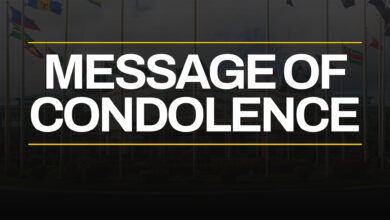It is a pleasure for the Assistant Administrator of AID, Mark Schneider, and me to welcome all of you to Washington to attend the third meeting of this Committee. Beyond the Department of State and the US Agency for International Development, our delegation includes experts from a broad spectrum of US agencies, including the Departments of Defense, Commerce and Labor; the Environmental Protection Agency; the National Oceanic and Atmospheric Administration; the Federal Aviation Administration; the Overseas Private Investment Corporation; the Office of the US Executive Director to the Inter-American Development Bank; and the Peace Corps. We are also pleased to have a representative of Governor McKay’s office, Mark Schlakman, and Carlos Vivoni and Alcides Ortiz of the government of Puerto Rico. We all look forward to fruitful discussions with you.
As we agreed, this first plenary session will be dedicated to an overall assessment of implementation by both the United States and the Caribbean of the Action Plan that our leaders approved at the Bridgetown Summit in May 1997. We have prepared three documents for you: the text of my opening statement and that of Mark Schneider’s and a matrix geared to the Action Plan, paragraph by paragraph.
The Bridgetown Summit was distinguished by a serious, concerted joint effort to examine the U.S.-Caribbean relationship and to determine the best means of deepening the engagement between the United States and the Caribbean, at both the public and private level. The Summit produced the Bridgetown Declaration and Action Plan, which defined goals and set up a process to achieve them. Let me turn first to a review of the process.
In the two years since Bridgetown, there have been three formal meetings between Secretary of State Albright and the Bridgetown Summit Foreign Ministers– in October 1997, April 1998, and October 1998. There also was a meeting this May with Prime Ministers Arthur of Barbados and Mitchell of Grenada.
There have been eight meetings of senior officials charged with following-up the implementation of the Bridgetown Action Plan:
- The Trade and Investment Council met in Miami in September 1997.
- The “Quick-Consult” mechanism met on bananas in October 1998 and May 1999.
- The Justice and Security Committee met in Miami in September 1997 and again in a teleconference in September 1998.
- Our own Committee met in September 1997 in Miami, September 1998 in Antigua, and today in Washington.
We are unaware of any time when has there has been more intensive consultation nor when there has been a more active high-level policy dialogue among our countries.
This dialogue has allowed all of our leaders to express frankly our concerns and expectations. We have not always held identical positions nor reached unanimous agreement. But as a result of the dialogue, your concerns have been heard and weighed very carefully in the daily process of decision-making within the US government. And we believe your influence on our thinking is reflected in the progress we have made implementing the Bridgetown Summit Agenda.
With respect to the goals that the Bridgetown process was set up to achieve, the over-arching goal is to assist the Caribbean private sector to increase its competitiveness and participate more fully in the global economy. This is the only way for any country to take full advantage of today’s extraordinary rate of technological change and economic progress.
That is why the Action Plan emphasizes the enhancement of the region’s skills and institutions: better trained and educated people; more efficient and cheaper telecommunications and aviation; better protection of the environment for tourism development; better preparedness for natural disasters; and increased flows of trade, investment and private financing.
We also recognize that aid from official donors remains an important part of building the competitiveness of this region. Since the Bridgetown Summit, bilateral programs of the US Agency for International Development (USAID) in the Caribbean have all received increased funding levels. Indeed, Caribbean countries are among the highest beneficiaries on a per capita basis of US aid in the world.
For the two years since the Bridgetown Summit (Fiscal Years 1998 and 1999), the US is providing assistance to the English-speaking Caribbean of more than $40 million. (This does not include the large programs we have in Haiti and the Dominican Republic). On a per capita basis, our aid to the English-speaking Caribbean amounts to $11, compared to an average of about $3 per capita for all aid-receiving countries of the Western Hemisphere. In FY 1998 and 1999, the US is providing a total of $17 million in regional projects which either specifically target the Eastern Caribbean or for which the Eastern Caribbean is the primary beneficiary. This is equivalent to $32 on a per capita basis.
I am very pleased that AID’s Assistant Administrator for Latin America and the Caribbean, Mark Schneider, is here to describe to you AID’s plans for the Caribbean over the next five years. We have developed, in close consultation with Caribbean governments and regional organizations, a program for Fiscal Years 2000 to 2005 which will focus on four areas of key importance to the Caribbean: employment; the environment; the administration of justice; and disaster mitigation. Funds for future programs will, of course, need to be appropriated by the US Congress, but we intend to seek a total of $30 million in funding for this plan, and it enjoys strong support from Secretary Albright.
In addition to USAID, a large number of US agencies and departments have developed cooperative links with the Caribbean. The broad range of US economic cooperation with the Caribbean becomes obvious as we review progress under each point of the Bridgetown Action Plan.
Some elements of the Action Plan are handled by the other two follow-up mechanisms established by our leaders in Bridgetown. The Trade and Investment Council (TIC) handles the first four points under Enhancement of Trade and Investment, as well as the chapter on the Free Trade Area of the Americas. The Joint Committee on Justice and Security handles the nine specific action points under the Justice and Security chapter.
Despite the pressure of FTAA events, which has made it impossible to hold a TIC meeting this week, Peter Allgeier (Associate USTR for the Western Hemisphere) and Ralph Ives (Deputy USTR for Western Europe) are available for a short meeting tomorrow morning to update Caribbean trade officials on major trade issues. I understand that the Justice and Security Committee is planning to meet again within the next few weeks.
Let us turn now to our Committee’s work on the Action Plan, starting with the chapter on Enhancement of Trade and Investment. The goal of our cooperation in this area is to strengthen the ability of the private sector in your economies to generate additional trade and investment. Let me cite three examples of US assistance to reach this goal:
- In October 1998, US Embassies and the US Department of Commerce carried out a Business Development Mission to three Eastern Caribbean countries.
- In November 1998, the US National Institute of Standards and Technology (NIST) hosted a two-week workshop for public and private sector participants from CARICOM, with NIST funding the expenses of 25 Caribbean participants.
- In March of this year, the US Department of Commerce and the Government of the Dominican Republic held a Caribbean-US Trade and Investment Forum in the Dominican Republic.
We are organizing additional commercial events for the coming year, including a trade exhibition in Trinidad in October, and conferences on Tourism Infrastructure Development and on Telecommunications in 2000. We welcome your suggestions on these and other possible activities.
The existence of a Bilateral Investment Treaty (BIT) has proved to be an important demonstration to potential investors of a country’s positive investment climate. Three such treaties are now in effect in the Caribbean: with Grenada, Jamaica, and Trinidad and Tobago. If there is interest by other Caribbean countries, we would be happy to arrange a briefing.
With regard to the aid requests listed in the Action Plan, USAID now has underway a number of training and technical assistance programs. These include agriculture and food technology, information technology, reform of trade-related laws, and development of an electronic virtual secretariat for the use of the Caribbean’s Regional Negotiating Mechanism. Mark Schneider will speak about these programs in greater detail.
The Action Plan’s Telecommunications chapter focuses on the increasing the region’s competitiveness and attractiveness to investment. US agencies have responded to requests by a number of Caribbean experts to receive training, both through the Federal Communications Commission’s Visitors Program and through the U.S. Telecommunications Training Institute (USTTI).
- Three Caribbean officials received scholarships to attend USTTI training, and the State Department is working with USTTI to respond to additional requests.
- USAID and USIA, supported by a loan from the State Department’s Telecommunications Leadership Fund, organized with the Center for Strategic and International Studies (CSIS) a series of seminars on various regulatory issues. This was in response to an OECS request in the context of its work with the World Bank on regulatory reform. These seminars were held in various sites in the Caribbean in February, May and July 1999, with the participation of a number of USG experts.
- USAID Jamaica also worked closely with the private sector and non-governmental organizations to develop and fund a seminar requested by the Caribbean Telecommunications Union on regulatory issues. This seminar was held in Miami in April 1999.
We are also prepared to begin discussions with the Caribbean on possible telecommunications action items for the next summit of the Americas. The Santiago Summit’s items were largely shaped by the Inter-American Telecommunication Commission (CITEL), a body with relatively sparse Caribbean participation. The United States believes that, working together, we can develop action items that raise to the top of CITEL’s agenda issues of specific relevance to the needs of the Caribbean.
The United States and the Caribbean are also exploring how electronic commerce may relate to negotiations for a Free Trade Area of the Americas. Internet applications such as electronic commerce appear a natural follow-up to the work of the Joint Committee, which has focused on reforming the regulatory environment as a means of attracting resources to acquire the physical infrastructure needed to exploit the information age.
The chapter on Economic Development and Financial Flows affirmed the importance of sound economic policies that provide the environment for private sector investment as a complement to – and ultimately as a replacement for – official assistance. The focus of these programs is on developing capital markets, promoting regional integration and strengthening credit institutions.
In February 1999 the US Overseas Private Investment Corporation joined with Citibank to open a new $200 million credit facility designed to spur private investment in the Caribbean and Central America. In the working group this afternoon, our OPIC representative will give you more detail about this program. I hope you will transmit to your private sectors this new opportunity for financing of development projects in the Caribbean.
The United States and all other bilateral and multilateral donors to the Caribbean meet with Caribbean leaders every two years to establish priorities for aid to the region, coordinate programs and promote private sector growth. The Steering Committee of this group, the Caribbean Group for Cooperation in Economic Development (CGCED), met in Washington in May for a very fruitful exchange of views. In 1998, the World Bank and the Inter-American Development Bank provided more than $200 million to the English-speaking Caribbean. (This does not include funds approved for Haiti and the Dominican Republic, nor lending to the English-speaking Caribbean by the Caribbean Development Bank.) The United States is by far the single greatest shareholder and contributor to these institutions.
One of the issues raised by the Eastern Caribbean with regard to multilateral lending is OECS membership in the Inter-American Development Bank. The United States will support and help facilitate OECS membership. This afternoon, Mr. Bruce Juba from the Office of the US Executive Director at the IDB, will give you more details on that issue.
The Action Plan’s chapter on Disaster Preparedness and Response stresses how preparedness and pre-planned response can substantially reduce the impact of disasters. US agencies, especially USAID’s Office of Foreign Disaster Assistance (OFDA) and the National Oceanic and Atmospheric Administration (NOAA) have a long working history with their Caribbean counterparts to plan for, detect, monitor and respond to natural disasters.
This cooperation is being strengthened, for example through additional training, improved Caribbean capacity for short-range climate forecasting, improved preparedness materials for the public, and integration of disaster mitigation practices into building standards and development planning. OFDA is also working with regional institutions like the Caribbean Disaster Emergency Response Agency (CDERA) to improve the region’s pool of disaster management professionals through training and institution-strengthening activities. USAID/OFDA has in place a 5-year, $5 million Caribbean Disaster Mitigation project and is formulating with Caribbean counterparts appropriate follow-on activities.
Appropriate US agencies will respond to natural disasters in the region upon request. In the aftermath of Hurricane Georges, the US provided airlift and emergency supplies to the affected countries, as well as $1.5 million in initial assistance. Another $3 million in disaster relief for the Eastern Caribbean was recently authorized by the US Congress to repair the hospital in St. Kitts, strengthen schools, support agricultural revitalization, and provide additional technical assistance for disaster mitigation. The Southern Command of the US Armed Forces, working with CDERA, has established a program to speed up the delivery of supplies immediately after a disaster. The program includes a $1.7 million regional warehousing system for pre-positioned hurricane-relief supplies.
The states of the Eastern Caribbean have taken an unprecedented step in pre-planned response to disasters by developing a sub-regional search and rescue plan and implementing agreement. This effort offers an example to all of Latin America and the Caribbean of how complex issues that can be addressed through regional cooperation. In fact, with the assistance of the US Federal Aviation Administration (FAA), US Coast Guard, and the International Civil Aviation Organization (ICAO), the states of the Eastern Caribbean may extend this cooperative mechanism to the entire Caribbean region.
The Action Plan’s chapter on Aviation recognized the importance of safe and growing air transport to the region’s vital tourism industry and to overall economic development. The United States believes that Open Skies aviation agreements could increase air traffic to the region. Aruba and the Netherlands Antilles have signed Open Skies agreements. US experts remain ready to hold discussions with the civil aviation authorities of Caribbean countries on the US model text for Open Skies agreements. This text has become a standard for liberalizing international air service and has been accepted by 35 countries in Europe, Asia, the Middle East and the Americas.
US and Caribbean aviation safety authorities have a long history of cooperation that has benefited both sides. The FAA is working with the Directors of Civil Aviation of the Eastern and Central Caribbean, as well as the CARICOM Secretariat and ICAO, on a series of specific programs to strengthen that cooperation. Among these are assistance programs in support of the development of new air traffic routes and the transition to satellite navigation technologies. In addition, the US remains committed to providing guidance and technical assistance to CARICOM when the final regulatory and institutional structure of the Association of Civil Aviation Authorities of the Caribbean is determined.
Educational cooperation is a critical part of the Action Plan and is one of the core areas of US-Caribbean relationships in both the private and public sectors. We are dedicating over $1 million in scholarships for Caribbean students to study in the US or in the Caribbean at various levels ranging from graduate-level university studies to specialized short-term training. These programs emphasize fields which are in greatest need for the continued modernization and diversification of Caribbean economies, such as infomatics, management and agricultural technology. Micro-enterprise skills training has also been expanded, reaching individuals who traditionally do not have access to training. In addition, education, particularly for at-risk youth, is the primary area of work for the Peace Corps Volunteers serving in the Caribbean. There are about 350 volunteers, of which 100 serve in the Eastern Caribbean.
The Action Plan’s chapter on Sustainable Development noted that the major economic activities of the Caribbean (such as tourism, mining, agriculture, fishing and forestry) are extremely dependent on preservation of the environment. The United States, as a bordering country of the Caribbean sea, shares its neighbors’ desire to maintain the quality and integrity of the Caribbean Basin.
USAID is supporting a number of environmental programs through both regional and global projects. For example, the US strongly supports Caribbean efforts in the context of the International Coral Reef Initiative and Global Coral Reef Monitoring Network, the International Queen Conch Initiative, and the UN Agreement for the Conservation and Management of Fish Stocks.
At the regional level, we have provided financial and technical support since the beginning of the negotiations on the development of a protocol to the Cartagena Convention on Protection of the Marine Environment from Land-based Activities. Government representatives from the wider Caribbean will meet in Aruba at the end of September to finalize the protocol. Building on these and other, existing programs, USAID’s new five-year strategy for the Caribbean includes an environmental component which will respond to Caribbean concerns.
We are looking forward to working closely with our Caribbean partners to ensure a successful outcome in September to the United Nations Special Session on the Sustainable Development of Small Island Developing States (SIDS). We were particularly enthusiastic about the discussions that took place during the joint meeting of small islands and donors this past spring and the potential for improved partnerships to address sustainable development. We look forward to a continued cooperative spirit in the resolution of the remaining outstanding issues. We consider the SIDS process to be an important opportunity to emphasize the special challenges facing SIDS and to foster strong relationships among SIDS and the international community.
I am pleased that we are also having a discussion on labor issues as part of our regional agenda. Following up on Secretary of Labor Herman’s January visit to Port of Spain, Deputy Under Secretary Andrew Samet will join the Working Group on Development’s discussion this afternoon.
In reviewing this inventory of US actions in fulfillment of the Bridgetown Action Plan, I was impressed once again by the breadth of our activities. There are close working relationships between Caribbean and US experts in every area of economic activity. I believe that the scope of cooperation at the technical level has not been fully appreciated by the media and the wider public. The Bridgetown mechanisms are helping to coordinate and deepen this work.
We cannot expect instant success for all our efforts in all these sectors. Some of the issues – in the sections on the environment or education, for example – will require continued and sustained cooperation over many years to reach their objectives fully. But there is important work underway which is already improving the quality of life for our people, with the prospect of major improvements over the longer run.
In the coming weeks, I will leave for another assignment, and responsibility for our relations with the Caribbean passes to my replacement, William Brownfield. But I will be watching the work of the Bridgetown mechanisms from my new post in Lima with great personal interest. I can assure you that my successors in this Committee will bring to it the enthusiasm and care which the US-Caribbean economic relationship so clearly deserves.





